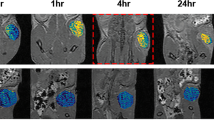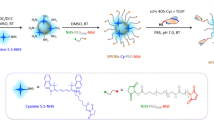Abstract
In this study, Trastuzumab modified Magnetic Nanoparticles (TMNs) were prepared as a new contrast agent for detecting HER2 (Human epidermal growth factor receptor-2) expression tumors by magnetic resonance imaging (MRI). TMNs were prepared based on iron oxide nanoparticles core and Trastuzumab modified dextran coating. The TMNs core and hydrodynamic size were determined by transmission electron microscopy and dynamic light scattering. TMNs stability and cytotoxicity were investigated. The ability of TMNs for HER2 detection were evaluated in breast carcinoma cell lines (SKBr3 and MCF7 cells) and tumor-bearing mice by MRI and iron uptake determination. The particles core and hydrodynamic size were 9 ± 2.5 and 41 ± 15 nm (size range: 15–87 nm), respectively. The molar antibody/nanoparticle ratio was 3.1–3.5. TMNs were non-toxic to the cells below the 30 μg (Fe)/mL concentration and good stable up to 8 weeks in PBS buffer. TMNs could detect HER2 oncogenes in the cells surface with imagable contrast by MRI. The invivo study in mice bearing tumors indicated that TMNs possessed a good diagnostic ability as HER2 specific contrast agent by MRI. TMNs were demonstrated to be able to selectively accumulate in the tumor cells, with a proper signal enhancement in MRI T2 images. So, the complex may be considered for further investigations as an MRI contrast agent for detection of HER2 expression tumors in human.










Similar content being viewed by others
References
Agrawal A, Gutteridge E, Gee JMW, Nicholson RI, Robertson JFR (2005) Overview of tyrosine kinase inhibitors in clinical breast cancer. Endocr Relat Cancer 12:135–144
Albanell J, Codony J, Rovira A, Mellado B, Gascon P (2003) Mechanism of action of anti-HER2 monoclonal antibodies: scientific update on Trastuzumab and 2C4. Adv Exp Med Biol 532:253–268
Artemov D, Mori N, Okollie B, Bhujwalla ZM (2003) MR molecular imaging of the HER2/neu receptor in breast cancer cells using targeted iron oxide nanoparticles. Mag Res Med 49:403–408
Bange J, Zwick E, Ullrich A (2001) Molecular targets for breast cancer therapy and prevention. Nat Med 7:548–552
Bhattarai SR, Bahadur KCR, Aryal S, Bhattarai N, Kim SY, Yi HK, Hwang PH, Kim HY (2008) Hydrophobically modified chitosan/gold nanoparticles for DNA delivery. J Nanopart Res 10:151–162
Brannon-Peppas L, Blanchette JO (2004) Nanoparticle and targeted systems for cancer therapy. Adv Drug Deliver Rev 56:1649–1659
Davoli A, Hocevar BA, Brown TL (2010) Progression and treatment of HER2-positive breast cancer. Cancer Chemother Pharmacol 65:611–623
Funovics MA, Kapeller B, Hoeller C, Sud HS, Kunstfeld R, Puig S, Macfeld K (2004) MR imaging of the HER2/neu and 9.2.27 tumor antigens using immunospecific contrast agents. Magn Reson Imaging 22:843–850
Hosseinkhani H, Hosseinkhani M (2009) Biodegradable polymer-metal complexes for gene and drug delivery. Curr Drug Saf 4:79–83
Hosseinkhani H, Tabata Y (2003) In vitro gene expression by cationized derivatives of an artificial protein with repeated RGD sequences, Pronectin. J Control Release 86:169–182
Hosseinkhani H, Tabata Y (2004) PEGylation enhances tumor targeting of plasmid DNA by an artificial cationized protein with repeated RGD sequences, Pronectin. J Control Release 97:157–171
Hosseinkhani H, Tabata Y (2005) Ultrasound enhances in vivo tumor expression of plasmid DNA by PEG-introduced cationized dextran. J Control Release 108:540–556
Hosseinkhani H, Aoyama T, Ogawa O, Tabata Y (2003) Tumor targeting of gene expression through metal-coordinated conjugation with dextran. J Control Release 88:297–312
Hosseinkhani H, Azzam T, Tabata Y, Domb AJ (2004) Dextran–spermine polycation: an efficient nonviral vector for in vitro and in vivo gene transfection. Gene Ther 11:194–203
Ito A, Shinkai M, Honda H, Kobayashi T (2005) Medical application of functionalized magnetic nanoparticles. J Biosci Bioeng 100(1):1–11
Johnstone A, Thorpe R (1996) Immunocytochemistry, immunohistochemistry and flow cytofluorimetry. Immunochemistry in practice, 3rd edn. Blackwell Science, Berlin, pp 313–380
Koyama Y, Barrett T, Hama Y, Ravizzini G, Choyke PL, Kobayashi H (2007) In vivo molecular imaging to diagnose and subtype tumors through receptor-targeted optically labeled monoclonal antibodies. Neoplasia 9(12):1021–1029
Kumar-Guptaa A, Guptab M (2005) Synthesis and surface engineering of iron oxide nanoparticles for biomedical applications. Biomaterials 26:3995–4021
Lowry OH, Rosebrough NJ, Farr L, Randal RJ (1951) Protein measurement with the Folin phenol reagent. J Biol Chem 193:265–269
Martin AL, Hickey JL, Ablack AL, Lewis JD, Luyt LG, Gillies ER (2009) Synthesis of bombesin-functionalized iron oxide nanoparticles and their specific uptake in prostate cancer cells. J Nanopart Res 12(5):1599–1608
Mosmann T (1983) Rapid colorimetric assay for cellular growth and survival: application to proliferation and cytotoxicity assays. J Immunol Methods 65:55–63
Nahta R, Esteva FJ (2003) HER2-targeted therapy—lessons learned and future directions. Clin Cancer Res 9:5048–5078
Potter M (1985) History of the BALB/c family. Curr Top Microbiol Immunol 122:1–5
Siddiqa A, Long LM, Li L, Marciniak RA, Kazhdan I (2008) Expression of HER-2 in MCF-7 breast cancer cells modulates anti-apoptotic proteins Survivin and Bcl-2 via the extracellular signal-related kinase (ERK) and phosphoinositide-3 kinase (PI3K) signalling pathways. BMC Cancer 2(8):129
Soto KF, Carrasco A, Powell TG, Garza KM, Murr LE (2005) Comparative in vitro cytotoxicity assessment of some manufactured nanoparticulate materials characterized by transmission electron microscopy. J Nanopart Res 7:145–169
Souiri M, Mora-Ponsonnet L, Glinel K, Othmane A, Jouenne T, Duncan AC (2009) Surface assembly on biofunctional magnetic nanobeads for the study of protein-ligand interactions. Coll Surf B Biointerfaces 68:125–129
Thorek DLJ, Chen AK, Czupryna J, Tsourkas A (2006) Superparamagnetic iron oxide nanoparticle probes for molecular imaging. Ann Biomed Eng 34(1):23–38
Yeh CH, Hsiao JK, Wang JL, Sheu F (2010) Immunological impact of magnetic nanoparticles (Ferucarbotran) on murine peritoneal macrophages. J Nanopart Res 12(10):151–160
Author information
Authors and Affiliations
Corresponding author
Rights and permissions
About this article
Cite this article
Rasaneh, S., Rajabi, H., Babaei, M.H. et al. MRI contrast agent for molecular imaging of the HER2/neu receptor using targeted magnetic nanoparticles. J Nanopart Res 13, 2285–2293 (2011). https://doi.org/10.1007/s11051-010-9991-5
Received:
Accepted:
Published:
Issue Date:
DOI: https://doi.org/10.1007/s11051-010-9991-5




